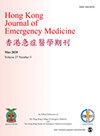Predictors for in-flight medical interventions during helicopter interfacility transport in Hong Kong
IF 0.8
4区 医学
Q4 EMERGENCY MEDICINE
引用次数: 0
Abstract
Introduction: Interfacility transport with helicopter from remote island clinics to urban hospitals account for a significant portion of the Hong Kong Government Flying Service missions. Currently, doctor and nurse escorts are deployed as volunteers only during the daytime from every Friday to Monday and on public holidays. While most transport runs smoothly, patient deterioration can occur during flight, warranting medical interventions on-board. Yet, little is known about the pattern and any clinical predictors of such interventions during helicopter interfacility transport missions. Methods: We collected Government Flying Service callout records from 1 January to 31 December 2016, and retrieved demographic, clinical and operational data. Interfacility transport mission was dispatched based on ‘Casualty Evacuation’ categories, which range from A+ (unstable), A (borderline) to B (stable). Univariate and multivariable logistic regression were used to identify independent predictors for in-flight medical interventions. Results: Of 1734 callout records, 386 interfacility transport missions escorted by volunteer doctors or nurses or both had complete flight medical records for analysis and 14.9% required in-flight medical interventions. Most interventions were related to oxygen therapy, intravenous fluid and administration of medications. Multivariable logistic regression showed that an age ⩾70 years, Casualty Evacuation A+ category, and any pre-flight emergency medical interventions were independent predictors for in-flight medical interventions. Conclusion: This study identified a few clinical predictors of in-flight medical interventions in an urban helicopter interfacility transport missions setting. Crewman training that focuses on the relevant procedural capabilities and clinical judgement is necessary to address the in-flight medical needs of interfacility transport missions.香港直升机跨设施运输过程中空中医疗干预的预测因素
导言:香港政府飞行服务队的任务中,有相当一部分是用直升机将偏远岛屿的诊所送往市区医院。目前,医生和护士护卫队只在每周五至周一的白天和公众假期作为志愿者部署。虽然大多数运输都很顺利,但在飞行过程中可能会出现病人病情恶化,需要在飞机上进行医疗干预。然而,在直升机设施间运输任务中,对这种干预的模式和任何临床预测因素知之甚少。方法:收集2016年1月1日至12月31日的政府飞行服务队征召记录,检索人口统计、临床和业务数据。设施间运输任务是根据“伤亡疏散”类别派遣的,范围从A+(不稳定),A(边缘)到B(稳定)。使用单变量和多变量逻辑回归来确定飞行中医疗干预的独立预测因素。结果:在1734份调出记录中,386份由志愿医生或护士陪同的设施间运输任务有完整的飞行医疗记录供分析,14.9%需要飞行中医疗干预。大多数干预措施与氧疗、静脉输液和药物管理有关。多变量logistic回归显示,年龄大于或等于70岁、伤亡疏散A+类别和任何飞行前紧急医疗干预是飞行中医疗干预的独立预测因素。结论:本研究确定了城市直升机设施间运输任务设置中飞行中医疗干预的一些临床预测因素。以相关程序能力和临床判断为重点的机组人员培训对于满足设施间运输任务的飞行医疗需求是必要的。
本文章由计算机程序翻译,如有差异,请以英文原文为准。
求助全文
约1分钟内获得全文
求助全文
来源期刊

Hong Kong Journal of Emergency Medicine
EMERGENCY MEDICINE-
CiteScore
1.50
自引率
16.70%
发文量
26
审稿时长
6-12 weeks
期刊介绍:
The Hong Kong Journal of Emergency Medicine is a peer-reviewed, open access journal which focusses on all aspects of clinical practice and emergency medicine research in the hospital and pre-hospital setting.
 求助内容:
求助内容: 应助结果提醒方式:
应助结果提醒方式:


